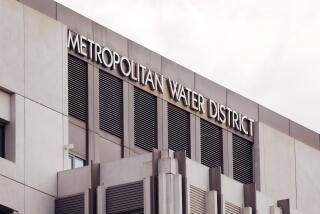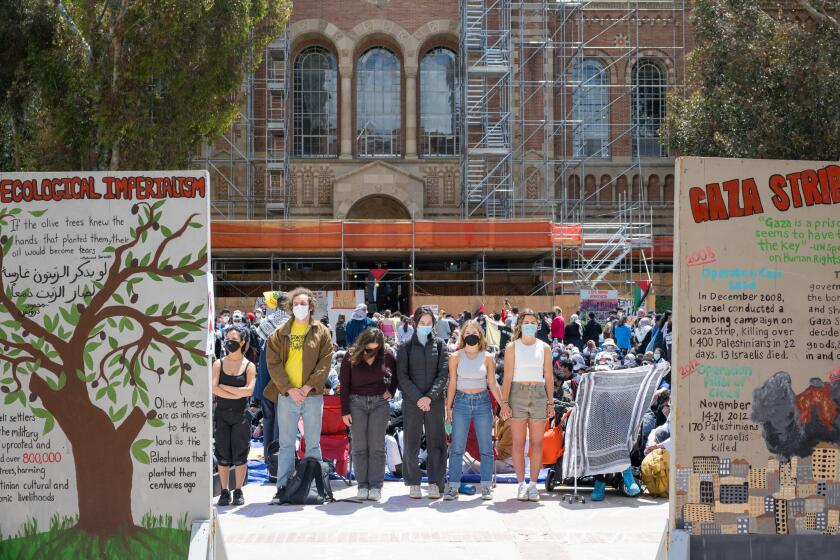Not enough water, L.A.? Look up.
On Nov. 5, 1913, William Mulholland stood before a crowd of 40,000 people near San Fernando and unfurled an American flag, signaling the official opening of the Los Angeles Aqueduct. As water from the Owens Valley rushed through the spillway for the first time, Mulholland exulted to the assembled onlookers: “There it is. Take it.”
It was a good line. But Mulholland should have pointed skyward — because that is the true source of our water.
Now, 100 years later, faced with water supply problems that mock Mulholland’s triumphalism, maybe we can finally get things right.
The difference between a water-starved Los Angeles and a water-sufficient Los Angeles doesn’t have to depend only on how much we can pull from the Owens Valley, the Sacramento-San Joaquin River Delta or the Colorado River. We have the power to alleviate the city’s water problems with rainwater we currently squander.
Rainwater has the potential to be a more important supply source than any other. In fact, given our critical need for water, rainwater may be the single most valuable natural resource possessed by the city. And yet, we waste it.
Instead of capturing this crucial resource in cisterns and aquifers, rainwater ends up flowing from gutters, to storm drains, to the ocean. But there’s a better way.
Since 1998, TreePeople, working with the county and city of Los Angeles and agencies such as the state Department of Water Resources, has turned Sun Valley into a national model for harvesting and reusing rainwater and floodwater.
Sun Valley has a long and troubled relationship with rain. The community was built without storm drains, and TV news crews looking for footage of flooded intersections during storms learned long ago to head straight for it.
But delivering Sun Valley from its flooding problems is only the beginning of the benefits offered by the Sun Valley Watershed Project. What makes the project unique is that it offers a single integrated plan to address flood protection, water quality and water conservation.
The most innovative component of the plan involves advanced water capture. The project uses both natural and engineered technologies that mimic — and even improve on — the original watershed. The project includes rain gardens (sunken areas in landscapes that capture rainwater from roofs and other impervious surfaces), vegetated bio-swales (creek-like rain gardens), constructed wetlands (which create wildlife habitat while cleaning storm water runoff through natural processes), and trees — planted with mulched root zones so water runoff is filtered and infiltrated into the aquifer.
Moderate-sized rain tanks are being installed around homes, as well as giant underground cisterns under schoolyards, parks and wildlife areas. That rainwater is then used not only to irrigate the areas where it was captured but also to recharge aquifers.
These innovations are being implemented in pilot projects around Los Angeles, including at Echo Park Lake and at the South Los Angeles Wetlands Park, where runoff from neighborhood streets is captured, cleaned and used to fill the lake and wetlands for wildlife habitat and recreation, while preventing pollution of the river and ocean.
Now it’s time to go full scale.
Spurred on by advocates, including Green LA Coalition’s local water committee and the Council for Watershed Health, public agencies across the region are looking at investments to create alternatives to importing water from far away. The pilot programs in Sun Valley and elsewhere have inspired Mulholland’s former employer, the Los Angeles Department of Water and Power, as well as the city’s Bureau of Sanitation, to begin decreasing our reliance on water imported from other places. The DWP is currently creating its first-ever master plan for storm water capture.
Could the methods of Sun Valley and these other projects be expanded to serve the entire city? Absolutely. The need is clear, the technology is available and the potential impact is historic. The key is for us to realize that Mulholland got it wrong, and that we’ve been making the same mistakes ever since.
Yes, we need to import water — that will always be a reality. But we won’t have to import as much if we learn to effectively use the treasure that drops to earth when it rains.
Water has always been, and will always be, the greatest natural challenge faced by Los Angeles, but a solution is near at hand. We just need to look up.
Andy Lipkis is the founder and president of TreePeople and a founding member of the Green LA Coalition.
More to Read
A cure for the common opinion
Get thought-provoking perspectives with our weekly newsletter.
You may occasionally receive promotional content from the Los Angeles Times.






